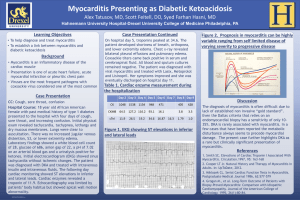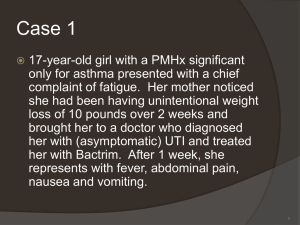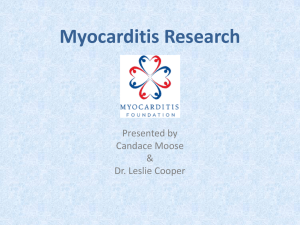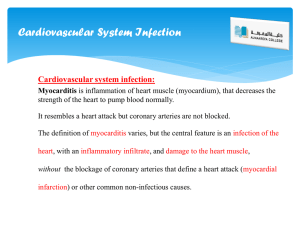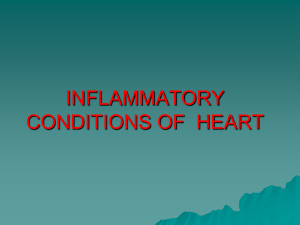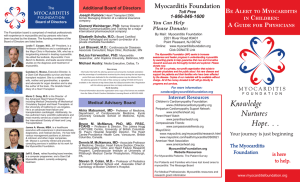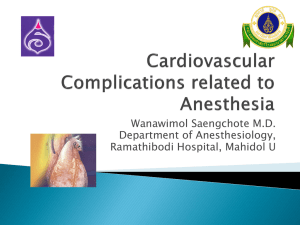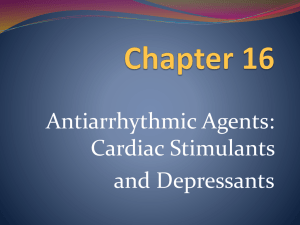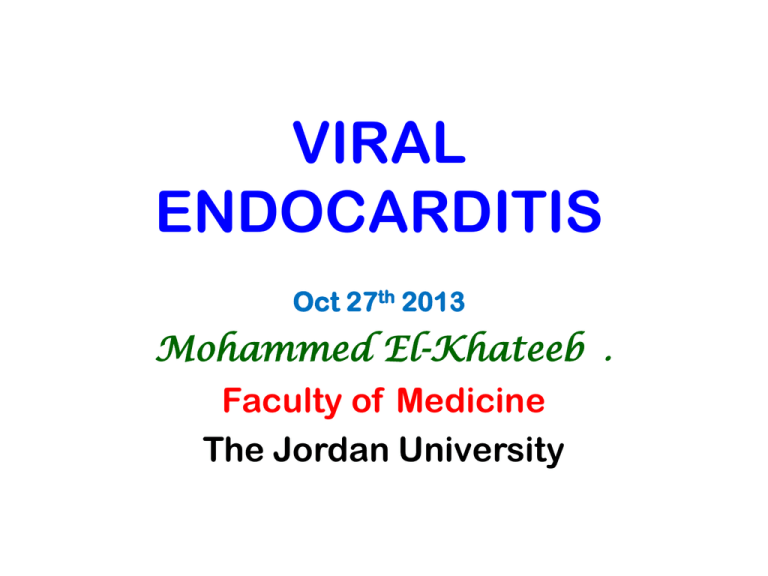
VIRAL
ENDOCARDITIS
Oct 27th 2013
Mohammed El-Khateeb .
Faculty of Medicine
The Jordan University
Outline
•
•
•
•
•
•
•
•
Definition
Historical Background
Pathogenesis
Clinical presentation
Etiologies
Diagnostics
Treatment
Prognosis
2
What is Myocarditis?
Myocarditis is an inflammatory disease of the
cardiac muscle
There are multiple etiologies including viral,
bacterial, parasitic, fungal, allergic, eosinophilic,
granulomatous, toxic, and post-viral immunemediated response
infiltrative etc..
It can be acute, subacute, or chronic, and there
may be either focal or diffuse involvement of the
myocardium
It is a histological, not a clinical diagnosis
the natural history is highly variable
Dallas criteria
• Active myocarditis: the presence of an
inflammatory infiltrate of the myocardium
with necrosis and/or degeneration of adjacent
myocytes not typical of the ischemic damage
associated with coronary artery disease
(CAD).
• Borderline myocarditis: the presence of an
inflammatory infiltrate of the myocardium
without necrosis or degeneration of adjacent
myocytes.
4
Historical Background
Recognized as early as 1806 as a persistent inflammatory
process of the myocardium following infections, such as
diphtheria, that led to progressive cardiac damage and
dysfunction
In 1837, the term myocarditis was first introduced to
describe inflammation or degeneration of the heart detected
by postmortem examination.
In 1980, Endomyocardial biopsy allowed the sampling of
human myocardial tissue during life and consequently
enabled antemortem diagnosis of myocarditis.
Evolution of viral causes of
myocarditis over time
Enterovirus Myocarditis
Nonenterovirus Myocarditis
CVA = coxsackievirus A; CVB = coxsackievirus B; EBV = Epstein-Barr virus;
HCV = hepatitis C virus; HHV6 = human herpesvirus 6; PV-B19 = parvovirus B19.
Characteristics
Myocarditis is a complex disease because multiple
pathogenetic mechanisms are involved.
While these mechanisms appear to act in a
chronological cascade, they undoubtedly overlap in
some cases, rendering diagnosis and treatment
difficult.
Ultimately, dilated cardiomyopathy (DCM) may result.
A multitude of still-circumstantial evidence points to a
major role for viral myocarditis in the etiology of DCM.
Characteristics
The common presence of viral genetic material and
viral proteins in the myocardium of patients with DCM
provides the most compelling evidence, but proof of
causality is still lacking.
Myocarditis is, by definition, an inflammatory disorder,
while dilated cardiomyopathy (DCM) is, in most cases,
idiopathic.
However, accumulating data has revealed an important
inflammatory component in the pathogenesis of DCM,
and there is growing evidence that myocarditis and
DCM are closely related.
PATHOGENESIS
Both direct viral-induced myocyte damage and
post-viral immune inflammatory reactions
contribute to myocyte damage and necrosis
Inflammatory lesions and the necrotic process
may persist for months, although the viruses only
replicate in the heart for at most two or three
weeks after infection
Evidence from experimental models has
incriminated cytokines such as interleukin-1 and
TNF, oxygen free radicals and microvascular
changes as contributory pathogenic factors
PATHOGENESIS
Three phases:
Viral Replication
Autoimmune injury
Dilated cardiomyopathy
PATHOGENESIS
Phase I: Viral Infection and Replication
Viruses like coxsackievirus B cause an
infectious phase, which lasts 7-10 days, and
is characterized by active viral replication
Virus infection directly contributes to cardiac
tissue destruction by cleaving the
cytoskeleton protein dystrophin, leading to a
disruption of the dystrophin-glycoprotein
complex causing the release of antigenic
intracellular components such as myosin
into the bloodstream
PATHOGENESIS
Phase II: Autoimmunity and injury
The local release of cytokines, such as
interleukin-1, interleukin-2, interleukin-6,
tumor necrosis factor (TNF), and nitric oxide
may play a role in determining the T-cell
reaction and the subsequent degree of
autoimmune perpetuation
These cytokines may also cause reversible
depression of myocardial contractility without
causing cell death.
PATHOGENESIS
Phase II: Autoimmunity and injury
Immune-mediated by CD8 lymphocytes
and autoantibodies against various
myocyte components
Antigenic mimicry, the cross reactivity of
antibodies to both virus and myocardial
proteins
Myocyte injury may be a direct result of
CD8 lymphocyte infiltration
PATHOGENESIS
Phase II: Autoimmunity and injury
Patients with myocarditis normally have an
imbalance between helper and cytotoxic T
cells; an inappropriate expression of the
MHC on cardiac tissues; and circulating
organ-specific autoantibodies in the serum.
The cytotoxic activity against healthy
cardiomyocytes was myocyte - specific,
induced by CD8+ lymphocytes and MHC
restricted.
PATHOGENESIS
Phase III: Dilated Cardiomyopathy (DCM)
Viruses may also directly cause myocyte apoptosis.
During the autoimmune phase, cytokines activate
the matrix metalloproteinase, such as gelatinase,
collagenases, and elastases.
In later stages of immune activation, cytokines play
a leading role in adverse remodeling and
progressive heart failure.
Cardiomyopathy develops despite the absence of
viral proliferation but is correlated with elevated
levels of cytokines such as TNF.
Pathophysiological process of
viral myocarditis.
Mechanisms of Viral and Immune Injury
There is a stunning array of mechanisms by which
cardiotropic viruses can cause congestive heart failure.
These include:
•
•
•
•
•
Myocytolysis by replicating virus in the absence of a specific
immune response
Cytotoxic T lymphocytes
Anti-cardiac antibodies
Fas ligand /Fas receptor pathway may bring T-lymphocytes and
myocytes together and cause ion channel disturbances as well
as apoptosis
Cytokines also contribute to both recovery from infection and to
worsened cellular injury during phase 1, as well as later phases.
Stages of Viral Myocardium Infection
New England Journal of Medicine 343:1391 2000
Pathophysiology
Myocarditis generally results in a decrease in
myocardial function, with concomitant enlargement of
the heart and an increase in the end-diastolic volume
caused by increased preload.
Normally, the heart compensates for dilation with an
increase in contractility (Starling law), but because of
inflammation and muscle damage, a heart affected
with myocarditis is unable to respond to the increase in
volume.
In addition, inflammatory mediators, such as cytokines
and adhesion molecules, as well as apoptotic
mechanisms are activated.
Pathophysiology
The progressive increase in left ventricular enddiastolic volume increases left atrial, pulmonary
venous, and arterial pressures, resulting in increasing
hydrostatic forces.
These increased forces lead to both pulmonary
edema and congestive heart failure.
Without treatment, this process may progress to
end-stage cardiac failure and death.
Viral Causes
Infecting organisms include the following:
Coxsackievirus types A and B, especially type B, are the most
common viral causes of myocarditis.
Adenovirus (types 2 and 5 most common)
Cytomegalovirus
Echovirus
Epstein-Barr virus
Hepatitis C virus
Herpes Simplex virus
Human immunodeficiency virus
Influenza and parainfluenza viruses
Measles virus
Mumps, associated with endocardial fibroelastosis (EFE)
Parvovirus B19
Poliomyelitis virus
Rubella virus
Varicella -Zoster virus
Coxsackieviruses
Coxsackie B viruses are estimated to be
responsible for at least 50% of the cases of
infection-caused heart diseases.
For reasons yet unknown, the cardiac disease
caused by this virus mainly occurs in middle-aged
men, with onset occurring, on average, around
age 42 years.
The cardiac disease becomes apparent about two
weeks after exposure to the virus.
Clinical Presentation
Clinical presentation varies considerably.
In mild forms, there are few or no
symptoms.
In severe cases, patients may present
with acute cardiac decompensation and
progress to death.
Clinical Presentation
Most cases of acute myocarditis are clinically silent
60% of patients had antecedent flulike symptoms
Large number identified by heart failure symptoms
35% of patients with myocarditis and HF have chest
pain
May mimic an acute MI with ventricular dysfunction,
ischemic chest pain, ECG evidence of injury or Q waves
Clinical Presentation
May present with syncope, palpitation with AV
block or ventricular arrhythmia
May cause sudden death
• myocarditis found at autopsy in 20% of Air
Force recruits with sudden death*
May present with systemic or pulmonary
thromboembolic disease
Clinical Manifestations
A variety of cardiac symptoms can be induced by
myocarditis
Chest pain may occur, usually due to concomitant
pericarditis
Excessive fatigue or decreased exercise ability may be
the initial sign of myocardial dysfunction
Since both ventricles are generally involved, patients
develop biventricular failure
Patients present with signs of right ventricular failure such
as hepatomegaly, and peripheral edema
If there is predominant left ventricular involvement, the
patient may present with the symptoms of pulmonary
congestion: dyspnea, orthopnea, rales, and, in severe
cases, acute pulmonary edema
Coxsackie Virus Clinical
Manifestations
The early symptoms of the coxsackie -induced cardiac
myopathy include some generalized viral symptomsfever, fatigue, malaise-with the addition of chest
pain.
As the virus enters the heart cells, the immune
system attacks and damages both infected and
normal heart cells; the affected individual feels
severe fatigue when there is significant impairment
of heart function.
In most cases, the disease is resolved spontaneously
without any treatment, though some permanent
heart damage may have occurred
Coxsackie Virus Clinical
Manifestations
In about 20% of the cases, there can be
progressive disease or recurrence of symptoms;
the heart damage can be extensive, causing
arrhythmias, weakened left ventricular functions,
and, in the worst cases, heart failure requiring
heart transplantation.
In these severe cases, cardiac disease
progression persists after the virus is long gone;
the immune system continues to damage the
heart.
Heart failure: This is the most common presenting
picture in all ages.
Chest pain: Although rare in young children, this
may be the initial presentation for older children,
adolescents, and adults.
Chest pain may be due to myocardial ischemia or
concurrent pericarditis.
Arrhythmia:
Patients can present with any type of
dysrhythmia, including ;
Atrioventricular conduction disturbances.
Sinus tachycardia is typical and the rate is
faster than expected for the degree of fever
present, which is typically low-grade.
Junctional tachycardia is also seen and can be
difficult to control medically.
Physical Findings
Signs of diminished cardiac output, such as
tachycardia, weak pulse, cool extremities, decreased
capillary refill, and pale or mottled skin may be
present.
Heart sounds may be muffled, especially in the
presence of pericarditis.
Hepatomegaly may be present in younger children.
Rales may be heard in older children.
Jugular venous distention and edema of the lower
extremities may be present.
Physical Findings
In addition to the signs of fluid overload, the physical
examination often reveals direct evidence of cardiac
dysfunction in symptomatic patients
S3 and S4 gallops are important signs of impaired
ventricular function
If the right or left ventricular dilatation is severe,
auscultation may reveal murmurs of functional mitral
or tricuspid insufficiency
A pericardial friction rub and effusion may become
evident in patients with myopericarditis
Neonates
Neonates may seem irritable, be in respiratory
distress, and exhibit signs of sepsis.
Somnolence, hypotonia, and seizures can be
associated if the CNS is involved.
Hypothermia or hyperthermia, oliguria, elevated
liver enzymes and elevated blood urea nitrogen
and creatinine caused by direct viral damage
and/or low cardiac output may be present.
Infants
Signs include failure to thrive, anorexia, tachypnea,
tachycardia, wheezing, and diaphoresis with
feeding.
In severe cases, low cardiac output may progress to
acidosis and death.
End organ damage may occur because of direct viral
infection or because of low cardiac output.
CNS involvement may also occur.
Adolescents
Presentation may be similar to that of younger
children but with a more prominent decrease in
exercise tolerance, lack of energy, malaise, chest
pain, low-grade fever, arrhythmia, and cough.
End-organ damage and low cardiac output may
be present.
Diagnostics: Expanded Criteria for
Diagnosis of Myocarditis
• Category I: Clinical Symptoms
Clinical heart failure
Fever
Viral prodrome
Fatigue
Dyspnea on exertion
Chest pain
Palpitations
Pre-syncope or syncope
37
Category II: Evidence of Cardiac Structural
or Functional Perturbation in the absence of
Regional Coronary Ischemia
Echocardiography evidence
Regional wall motion abnormalities
Cardiac dilation
Regional cardiac hypertrophy
Troponin release
High sensitivity (>0.1 ng/mL)
Positive indium In 111 antimyosin scintigraphy
and
Normal coronary angiography or
Absence of reversible ischemia by coronary
distribution on perfusion scan
38
Category III: Cardiac Magnetic
Resonance Imaging
Increased myocardial T2 signal on inversion
recovery sequence
Delayed contrast enhancement after
gadolinium-DTPA infusion
39
Category IV: Myocardial biopsy –
Pathologic or Molecular Analysis
Myocarditis can be classified into:
Active myocarditis - Characterized by abundant inflammatory cells and
myocardial necrosis.
Borderline myocarditis - Characterized by an inflammatory response that
is too sparse for this type to be labeled as active myocarditis;
degeneration of myocytes is not demonstrated with light microscopy
Presence of viral genome of polymerase chain reaction or in situ
hybridization
80-100% specificity when performed from myocardial biopsy
40
A
C
B
Endomyocardial biopsy
A: Normal Myocardium
B: Borderline Myocarditis
C: Typical and diffuse myocarditis in each histologic section
Lab Diagnosis
Complete blood count with differential
• Acute anemia of any origin may cause heart failure, and chronic
anemia exacerbates heart failure; both respond to blood
transfusion.
• The presence of lymphocytosis or neutropenia supports diagnosis
of a viral infection.
Blood culture: It is important to rule out any bacterial infection
Viral culture: Nasopharyngeal and rectal swabs may help identify
etiology.
Viral Serology: A 4-fold increase in a specific titer from the acute to
convalescent phase is strong evidence of infection.
Molecular Tests:
• In situ hybridization
• Polymerase chain reaction (PCR)
Diagnosis
Echo changes i.e. LV dysfunction (in
69%), and segmental wall motion
abnormalities (64%), do not
differentiate myocarditis from other
cardiomyopathies.
Enzyme biomarkers
Elevated secondary to myocardial damage from
inflammatory cell infiltrates, cytokine activation and
virus- mediated cell death
More useful when high sensitivity thresholds are used
Troponin T threshold of >0.1mg/mL increases
sensitivity from 34% to 53% and a specificity of 94%
Cardiac biomarkers i.e. creatine kinase and troponin T
and I ( elvated in around 40%) are routinely measured
CKMB is not useful due to low predictive value.
ESR found to have low sensitivity and specificity.
Management of myocarditis
Management is dictated by clinical signs and
symptoms.
MANY proposed therapies, most have only a
theoretical basis. Some have been tested in
animal models
Conventional heart failure therapy is currently
the only accepted therapy for myocarditis
including ACE inhibitors, angiotensin receptor
blocking agents, diuretics, β-blockers or
amiodarone.
45
Treatments/Therapeutic
Approaches
•
•
•
•
•
•
Supportive Therapy
Immunosuppression
Interferon
Intravenous Immune Globulin
Immune Adsorption Therapy
Hemodynamic Support
46
Supportive Therapy
• First-line therapy
• Only a small proportion of patient require
hemodynamic support
• Treat this group same as for clinical heart
failure
– Diuretics
– IV Vasodilators: Nitroglycerin, Nesiritide
– ACEi, ARBs, B-blockers when stable
• Anti-inflammatory properties
47
Immunosuppression
• Unproven hypothesis
• No shortage of short trials, limited by
– High degree of spontaneous improvement in the
control and treatment arms
– Small sample size with heterogenous population
– Patchy nature of myocardial biopsy
– Lack of relationship between pathologic
abnormalities and clinical prognosis
48
Diet and Lifestyle
Restrict salt intake to 2-3g of sodium per day
Exercise especially during the acute phase of
Coxsackie virus B3 murine myocarditis
enhances viral replication rate, enhances
immune mechanisms and increases
inflammatory lesions and necrosis.
Resumption of physical activity can take place
within 2 months of the acute disease.
49
Prognosis
Most patients with acute myocarditis and mild cardiac
involvement recover without long-term sequelae
Patient with advance cardiac dysfunction, varied
outlook
Patients with severe hemodynamic collapse at
presentation actually have a good prognosis
93% transplant-free survival in 11 years
30% of those with chronic myocarditis may recover
50
Prognosis
• Poor Prognostic
Dilated cardiomyopathy with positive enteroviral
genome
Viral genome persistence on myocardial biopsy
Excessive apoptosis
• Myocardial expression of Fas ligand or tumor necrosis
factor receptor 1 showed minimal recovery
• Good prognosis
Echo evidence of small left atrial and LV size was
predictive of recovery in one small study
51
Epidemiology
No racial predilection exists.
No sex predilection exists in humans, but there is some
indication in laboratory animals that the disease may
be more aggressive in males than in females.
Certain strains of female mice had a reduced
inflammatory process when treated with estradiol.
In other studies, testosterone appeared to increase
cytolytic activity of T lymphocytes in male mice.
No age predilection exists.
Younger patients, especially newborns and infants, and
immunocompromised patients may be more
susceptible to myocarditis.
52
Mortality/Morbidity
With suspected coxsackievirus B, the mortality
rate is higher in newborns (75%) than in older
infants and children (10-25%).
Complete recovery of ventricular function has
been reported in as many as 50% of patients.
Some patients develop chronic myocarditis
(ongoing or resolving) and/or dilated
cardiomyopathy and may eventually require
cardiac transplantation.
53
PREVENTION
As a result of the widespread use of vaccination
in developed countries, myocarditis secondary
to measles, rubella, mumps, poliomyelitis, and
influenza is now rare
Similarly, the elimination of trichinosis by meat
inspection has eliminated this infection
It is possible that vaccines against other
cardiotropic viruses may prevent viral
myocarditis
Other Rare Causes of
Heart Infection
Bacterial Causes
- Diphtheria - Myocarditis
- Psittacosis (Chlamydia psittaci) - Endocarditis
- Q fever (Coxiella burnetii) - Pericarditis, myocarditis, and
endocarditis. Endocarditis is frequently associated with purpuric
rash, renal insufficiency, stroke, and heart failure.
- Typhus (Rickettsia spp) - Myocarditis
Parasitic Causes
- Chagas' Disease (Trypanosoma cruzi) - Myocarditis
- Trichinosis (Trichinella spiralis) - Myocarditis
- Amebiasis ( Entameba histolytica) - Pericarditis
- Trypanosomiasis (Trypanosoma brucei rhodesiense or T b
gambiense) - Myocarditis

